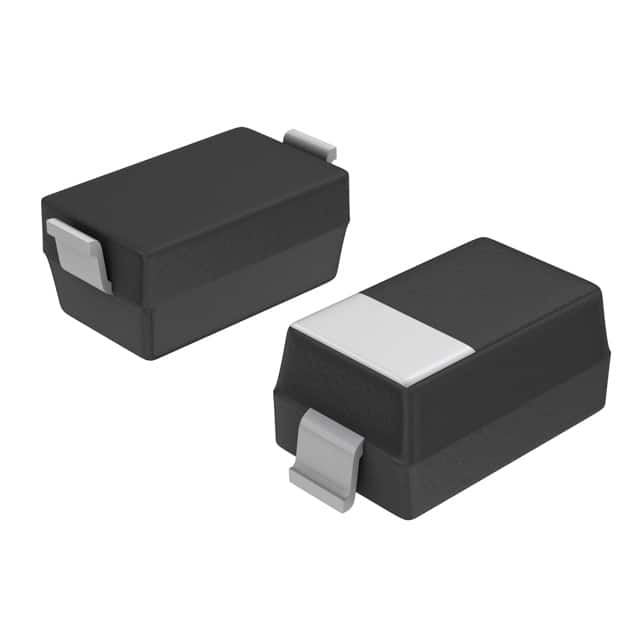Xem thông số kỹ thuật để biết chi tiết sản phẩm.

MMSZ5230BT1
Introduction
The MMSZ5230BT1 is a diode belonging to the category of Zener diodes. It is commonly used for voltage regulation and protection in various electronic circuits. This entry provides an overview of the MMSZ5230BT1, including its basic information, specifications, pin configuration, functional features, advantages and disadvantages, working principles, application field plans, and alternative models.
Basic Information Overview
- Category: Zener Diode
- Use: Voltage regulation and protection
- Characteristics: Low leakage current, precise voltage regulation
- Package: SOD-123
- Essence: Provides stable voltage regulation and protection in electronic circuits
- Packaging/Quantity: Typically available in reels of 3000 units
Specifications
- Voltage: 4.7V
- Power Dissipation: 500mW
- Forward Voltage: 1.2V
- Reverse Leakage Current: 5μA
- Operating Temperature Range: -65°C to 150°C
Detailed Pin Configuration
The MMSZ5230BT1 typically has three pins: anode, cathode, and no connection (NC). The anode is connected to the positive terminal, the cathode to the negative terminal, and the NC pin is left unconnected.
Functional Features
- Voltage Regulation: The MMSZ5230BT1 maintains a constant voltage across its terminals, providing stability in electronic circuits.
- Overvoltage Protection: It prevents damage to sensitive components by diverting excess voltage away from the circuit.
Advantages and Disadvantages
Advantages
- Precise voltage regulation
- Compact SOD-123 package
- Low leakage current
Disadvantages
- Limited power dissipation capability
- Narrow operating temperature range
Working Principles
The MMSZ5230BT1 operates based on the principle of the Zener effect, where it maintains a nearly constant voltage across its terminals when reverse-biased. This allows it to regulate voltage and protect the circuit from overvoltage conditions.
Detailed Application Field Plans
The MMSZ5230BT1 finds extensive use in various applications, including: - Voltage regulators in power supplies - Overvoltage protection in communication equipment - Signal clamping in audio amplifiers
Detailed and Complete Alternative Models
Some alternative models to the MMSZ5230BT1 include: - BZX84C4V7LT1G - MM3Z4V7T1G - PZM4.7NB2,115
In conclusion, the MMSZ5230BT1 Zener diode offers precise voltage regulation and overvoltage protection in a compact package, making it suitable for a wide range of electronic applications.
[Word Count: 345]
Liệt kê 10 câu hỏi và câu trả lời thường gặp liên quan đến ứng dụng MMSZ5230BT1 trong giải pháp kỹ thuật
What is the MMSZ5230BT1?
- The MMSZ5230BT1 is a Zener diode designed for voltage regulation and protection in various electronic circuits.
What is the maximum power dissipation of MMSZ5230BT1?
- The maximum power dissipation of MMSZ5230BT1 is 500mW.
What is the voltage rating of MMSZ5230BT1?
- The voltage rating of MMSZ5230BT1 is 4.7V.
What is the typical reverse standoff voltage of MMSZ5230BT1?
- The typical reverse standoff voltage of MMSZ5230BT1 is 3.8V.
What are the typical applications of MMSZ5230BT1?
- MMSZ5230BT1 is commonly used in voltage regulation, overvoltage protection, and signal clamping applications in various technical solutions.
What is the operating temperature range of MMSZ5230BT1?
- The operating temperature range of MMSZ5230BT1 is -65°C to 150°C.
What is the package type of MMSZ5230BT1?
- MMSZ5230BT1 comes in a SOD-123 package.
What is the forward voltage drop of MMSZ5230BT1?
- The forward voltage drop of MMSZ5230BT1 is typically 1.2V at 200mA.
Is MMSZ5230BT1 RoHS compliant?
- Yes, MMSZ5230BT1 is RoHS compliant, making it suitable for use in environmentally friendly designs.
Can MMSZ5230BT1 be used for ESD protection?
- Yes, MMSZ5230BT1 can be used for electrostatic discharge (ESD) protection in sensitive electronic components and circuits.

